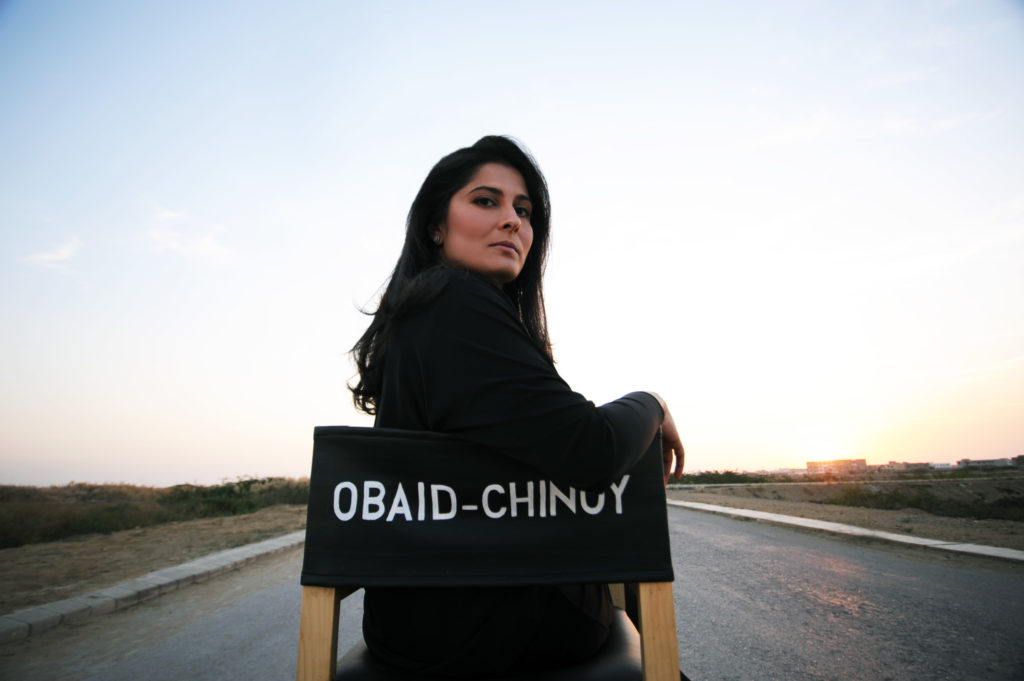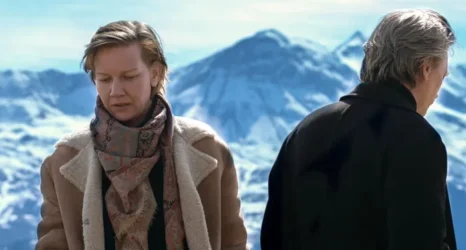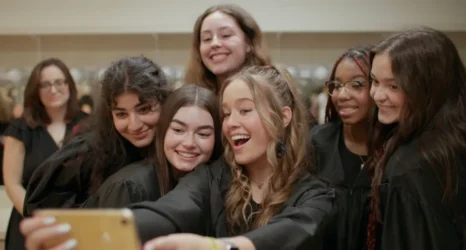Two-time Academy Award-winner and six-time Emmy Award winner Shameen Obaid-Chinoy has told dozens of stories, most of them feminist and many focused on women in the middle east. Sitara: Let Girls Dream, her latest, expands that collection of work—and calls on cultures and individuals across the globe to let girls dream.
Gloria Steinem, Ariel Wengroff and Nancy Dubuc are the Executive Producers of the animated short, which takes place in 1970’s Pakistan and tells the story of the titular character, a 14-year-old girl, who dreams of being a pilot but is forced, instead, to become a child bride. Masterfully and without dialogue, Sitara tells two distinct stories—one of women’s mourning for the lives they are not allowed to live, and another of the moments of shift that can transform the lives of girls in a rapidly modernizing world.
Obaid-Chinoy sat down with Ms. to look back on the factors that drove the story in Sitara, and the creative decisions that will hopefully spur activism in its viewers. In the process, the filmmaker looked forward toward her next challenges, and reflected on the conversations connecting her body of work.

I always start my conversations with people by asking for an inception story. How how does Sitara come to be? Where does the story of the story start?
I’m a documentary filmmaker, and for a while my team and I saw a pattern in the films that we were creating—the characters that we were interviewing, many of the young girls that we were speaking to, were child brides themselves. And the thing that struck me most in all of those conversations was that they talked about their dreams, and the fact that they had to give them up, or they were forced to give them up. So that is the origin of Sitara. It’s as much a story about child marriage as it is about a young girl’s dreams.
I was so curious, too, about some of the really specific decisions. Why a silent film? Why an animated film? Why a short film? What were the factors that shaped the way you decided to tell that story?
When I envisioned Sitara: Let Girls Dream, I envisioned it to be a film that could speak to anybody around the world, that it didn’t need a language—that it would have a language of its own in the expressions on the face of the characters, that we were drawing the world, that the world we were transporting people into would speak to each individual in a manner that would be different from another individual in screenings around the world. That’s just what’s happened. People who speak very different languages, who come from very different cultures, react very differently to the film and have their own takeaway. That’s what the idea was.
I also wanted to work in the medium of animation, because then you can create a world for two generations, and this is a conversation that we wanted two generations to have. Why is it that we are not investing in the dreams of our young girls? It’s a conversation that parents need to have, and it’s a conversation that children need to have about the future.
And I love shorts, because they can convey so much in such little time, and they can start electrifying conversations, and they have the ability to be screened in schools and colleges and community centers and have meaningful discussions right off in the screening and in the span of an hour.
That was also something I was thinking about: What kind of impact are you hoping that the film has?
Sitara was always meant to be a conversation starter, and that’s what we hoped was going to happen. Netflix allows us a global audience, which the film was always intended for. We’ve already been screening the films in the United States, in high schools, in Pakistan, in middle schools, with our partners around the world—and we knew we would continue to do that with the film because, it is not just a film.
Sitara was always meant to be movement: How can we, in 2020, be denying girls the right to dream? And the fact that it doesn’t cost anything to invest in the ability to allow a girl to dream. My team, the team behind Sitara, was determined right from the start to make a film that could be played every month and that could transcend time.
There are so many nuances in the film. The film is set in the 1970s, so set back in time with our language. Driven by music. We have really stayed true to fabrics, the design, the fashion of Pakistan—which is my home country. And so, you know, we wanted to take audiences around the world into our world, and to show the beauty of that as well.
You’re talking about a conversation—and you have such a body of work, and there are a lot of obviously overlapping things, right? A lot of your films deal with women’s equality. You’ve done a lot of work around these issues in Pakistan, or about folks in Pakistan. How do you think Sitara is also in conversation with your other work?
I am a storyteller—and depending on the medium, and the audience I want to reach, I’m now experimenting with style and form. I’ve been playing with virtual reality. I’ve been playing with animation. And the reason that I wanted Sitara to be animated was because I wanted to create the world of the two girls in the film. I wanted to be able to give them life. And I think that it’s a continuation of the conversations that I’ve been having throughout my career: this space that women have, the role of women, what young guns aspire to become, what holds them back.
How are we treating women today? How do women see themselves today? That’s reflected in the roles that you see in Sitara. You see the mother’s role, the sister’s role, the role of the community, the role of the father, the role of the brother—all of that, at some point or the other, has been drawn from a film that I’ve done or a character that I’ve met.
I noticed that the structure in which there was a little sister and a mother, that something that you really see in the film is that intergenerational trauma of sexism. How powerless the mother feels, how confused and disoriented the sister is around the idea of what’s happening, and of course, Sitara’s deep sadness at the life she wanted. How can that break down those really powerful structures that sort of feel like life sentences, like futures we didn’t want—how do you hope storytelling can shift that?
I have told two stories in Sitara: One story is the story you see in animation, and the other story you see in credits.
In the film, a young 14-year-old girl wants to become a pilot. She spends time on the rooftop making paper planes and flying and, unknown to her, her father is arranging her marriage—thinking that he is doing the right thing, because that is something that he had gone through. He just considers that part and parcel of his duty and obligation. She’s married off and the entire family stands against the father. The father has a realization that what he’s done may be wrong. In that moment, at the very end of the film, he offers a peace offering to his younger daughter—the crushed up paper plane left by the older daughter, who was married off.
And then, in the credits, you see the father paying attention to the younger daughter—allowing her the ability to dream, to go to school and eventually to become a pilot. In the very last frame of the credits, the younger daughter flies off, and you see the entire family waving off goodbye to her.
What I wanted to do was paint the picture as very gray, as not black and white. A lot of people make decisions because of culture, because of what they’ve already experienced, without realizing the times have changed, that that can no longer be acceptable. That’s the story I wanted to tell: the story of a young family caught in tradition and change.
I loved the idea of showcasing, through the father and the young boys in the film as well, the ways in which men also suffer from sexism—how hard it is for the father to realize that he has hurt his daughter, that he was trying to do the right thing for her, but he didn’t. Why was that an important part of the challenge that you wanted to issue to the culture? I feel like it’s easier to say: I’m a woman and I’ve gone through this and I didn’t like it and I feel for you because of it. But I was really intrigued by the way in which the father plays that central role of really feeling the pain of sexism.
The father and the brother in the film are caught in tradition. They are in a word where they’re expected to play a certain role. And we often forget that there are a lot of pressures on men—culturally, society places expectations on them, and they feel like they have to live up to those expectations, and that’s what the father was doing in the film. He was living up to the expectations that the society had placed on him.
It’s important to talk about that today, because the only way women will be free is if men realize that giving freedom, allowing freedom or giving that space, would be beneficial for everyone.
I want to circle back around to the idea of being a storyteller. What is it about film TV, documentary—what is it about those formats that draws you to those canvasses?
An effective storyteller elicits emotions, draws audiences in and takes them into a world, elicits empathy and allows people to walk in the shoes of other people, only in the way that film can. That’s why I’ve always chosen that as my canvas. I also think about film, in this changing world where people read less and have very short attention spans, as a way of grabbing you and forcing you to dig deep into an issue that you may not necessarily ever have gone into. The topics that I choose aren’t everyday topics. They’re topics that jolt you, that force you to have difficult conversations. Only film, I feel, can lend itself effectively to that.
What’s next—for the film and for you, as a filmmaker?
We have launched a campaign—a website, letgirlsdream.org. The film is available to be played in high schools and in community centers, and the Netflix launch happens March 8th, International Women’s Day. I’m traveling with the film and talking to children about the impacts of child marriage, but also more importantly about what’s holding them back from achieving their dreams, how we can empower them to achieve their dreams. And I am continuing to experiment with form… challenging myself a little bit about the worlds that I want to bring myself in and out of.
You know, people, people often ask me why I choose the subjects that I do and it’s really based on my barometer of anger. If something makes me very angry, that’s what I really want to focus on.
What about Sitara challenged you—what did it teach you?
Sitara is not just a film that I’ve made. It’s a film that’s been made by an entire team of people who have spent day and night working on creating these characters, giving them life.
The team that I work with, I’m very fortunate, they’re all self taught, you know—they’ve done YouTube tutorials, found mentors who Skyped in and taught them, they’ve experimented with form and style. Pakistan, which is where my home is and which is where the animation company that created Sitara is, we don’t have a formal education structure for animation, so we’re all self taught.
My co-producer, Eleyna Haroun—who really drew this project from the start, who really gave life to these characters, who would come with patterns to me and who would come with designs—she really wanted to make this as local as possible. My art director, Salman Nasir, found references and everything—from buildings to the kites in the air to the geometric patterns you see on the bedsheets. My animation director and Eleyna—because my animation team has a lot of men in it, and the characters that needed expression were all women, we got all these female actresses to come in and demonstrate so that they could copy them, and that entire process was spearheaded by the team on the ground. And then in post, in composite, you’re putting in the posters, and making sure that there was enough green, or making sure that the curtain blew as the morning light shown in—you know, it’s small nuances, but the team was responsible for bringing it to life.
I’ve gone to where we have frequent power outages and, and you know where our silver room got flooded, and our computers are very old, and the software that we use is very outdated. It’s a miracle that Sitara came to life and has come out into the world. And it’s something that the team is very proud of—that they, from Pakistan, made a small contribution to the world of animation.





